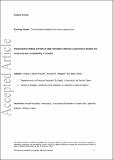Files in this item
Disassortative mating prevails in style-dimorphic Narcissus papyraceus despite low reciprocity and compatibility of morphs
Item metadata
| dc.contributor.author | Simón-Porcar, Violeta I. | |
| dc.contributor.author | Meagher, Thomas Robert | |
| dc.contributor.author | Arroyo, Juan | |
| dc.date.accessioned | 2016-08-20T23:34:22Z | |
| dc.date.available | 2016-08-20T23:34:22Z | |
| dc.date.issued | 2015-09 | |
| dc.identifier | 207951611 | |
| dc.identifier | 6fa3174e-c3d6-4e21-bd88-1c8192fb06b6 | |
| dc.identifier | 84941600569 | |
| dc.identifier | 000362964700003 | |
| dc.identifier.citation | Simón-Porcar , V I , Meagher , T R & Arroyo , J 2015 , ' Disassortative mating prevails in style-dimorphic Narcissus papyraceus despite low reciprocity and compatibility of morphs ' , Evolution , vol. 69 , no. 9 , pp. 2276–2288 . https://doi.org/10.1111/evo.12731 | en |
| dc.identifier.issn | 0014-3820 | |
| dc.identifier.uri | https://hdl.handle.net/10023/9345 | |
| dc.description.abstract | Evolution to reduce inbreeding can favor disassortative (inter-morph) over assortative (intramorph) mating in hermaphroditic sexually polymorphic plant species. Heterostyly enhances disassortative pollination through reciprocal placement of stigmas and anthers of morphs and appropriate pollinators. Stylar dimorphism in which there is not reciprocal anther placement may compromise disassortative mating, particularly when there is not intra-morph incompatibility. Variable rates of disassortative mating along with differential female fecundity or siring success among floral morphs could lead to variation in morph ratio. We investigated mating patterns, female fecundity and siring success of style-length morphs in Narcissus papyraceus, a self-incompatible but morph-compatible species with dimorphic (long- and short-styled) and monomorphic (long-styled) populations in central and north regions of its range respectively. We established experimental populations in both regions and exposed them to ambient pollinators. Using paternity analysis, we found similar siring success of morphs and high disassortative mating in most populations. Female fecundity of morphs was similar in all populations. Although these results could not completely explain the loss of dimorphism in the species’ northern range, they provided evidence for the evolutionary stability of stylar dimorphism in N. papyraceus in at least some populations. Our findings support the hypothesis that prevailing inter-morph mating is key for the maintenance of stylar dimorphism. | |
| dc.format.extent | 886767 | |
| dc.language.iso | eng | |
| dc.relation.ispartof | Evolution | en |
| dc.subject | Female fecundity | en |
| dc.subject | Heterostyly | en |
| dc.subject | Long-tongued pollinators | en |
| dc.subject | Morph ratio | en |
| dc.subject | Paternity analysis | en |
| dc.subject | Siring success | en |
| dc.subject | QH301 Biology | en |
| dc.subject | DAS | en |
| dc.subject.lcc | QH301 | en |
| dc.title | Disassortative mating prevails in style-dimorphic Narcissus papyraceus despite low reciprocity and compatibility of morphs | en |
| dc.type | Journal article | en |
| dc.contributor.institution | University of St Andrews. School of Biology | en |
| dc.contributor.institution | University of St Andrews. Centre for Biological Diversity | en |
| dc.contributor.institution | University of St Andrews. Scottish Oceans Institute | en |
| dc.contributor.institution | University of St Andrews. St Andrews Sustainability Institute | en |
| dc.contributor.institution | University of St Andrews. Centre for Evolution, Genes and Genomics | en |
| dc.contributor.institution | University of St Andrews. Centre for Research into Ecological & Environmental Modelling | en |
| dc.identifier.doi | https://doi.org/10.1111/evo.12731 | |
| dc.description.status | Peer reviewed | en |
| dc.date.embargoedUntil | 2016-08-20 | |
| dc.identifier.url | http://onlinelibrary.wiley.com/doi/10.1111/evo.12731/suppinfo | en |
This item appears in the following Collection(s)
Items in the St Andrews Research Repository are protected by copyright, with all rights reserved, unless otherwise indicated.

